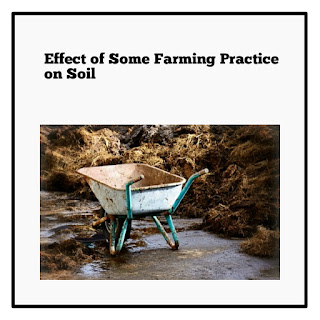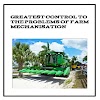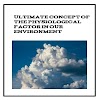Farm Practice
Farm practice are those things that happen on the farm land to produce crops and for ages for livestock grazing.
The following farming practice by farmer have effects on the soil.These are;
1. Bush Burning:- This is the burning of the bush or land to clear out the vegetations.
Advantages of Bush Burning
(i) It destroys the seed of the weeds.
(ii) Bush burning destroys the soil-borne pathogens.
(iii) Bush burning releases minerals like phosphorus and potassium to the which are present ash.
(iv) Bush burning helps to sterilize the soil because of the high temperature.
Disadvantage of Bush Burning
(i)Bush burning destroys the organic matter that is present in the soil.
(ii) Bush burning affects the PH of the soil.
(iii) Bush burning exposes the soil to erosion and leaching.
(iv) It reduces the population the soil living organisms.
(v) Bush burning may destroy the soil structure.
(vi) Bush burning leads the reduction in soil water content.
(vii) It leads to environmental pollution.
(viii) Due to ash remains on soil, this may leads to the increase of soil PH.
2. Overgrazing:- Overgrazing is the process whereby more animals fed on a piece of land land. This is the way of exceeding the capacity a land can carry.For example, 20 men are expected to fed on a piece of land and 40 animals are allowed to fed on it, this is overgrazing.
Advantages of Overgrazing
(i) Weeds can easily be eradicated on this piece of land.
(ii) As more animals are fed on the land, more feaces and urine are dropped on the land which will improve the fertility of the soil.
Disadvantages of Overgrazing
(i) This process exposes the soil to erosion.
(ii) It destroys the structure of the soil.
(iii) The regenerative capacity of the grasses will reduce.
(iv) Overgrazing destroys the vegetative that covers the soil.
(v) Overgrazing leads to poor growth of the plants.
(vi) Overgrazing encourages the compaction if the soil, which can result from the continuous trampling under animal hoofs.
(vii) Overgrazing leads to poor soil aeration due to pore spaces in the soil are being reduced.
3. Clean Clearing:- Clean clearing is the process whereby the whole land is cleared and removed, thus leaving the land clean.
Advantages of Clean Clearing
(i) Cleaning clearing get rid of weeds from the soil.
(ii) This clearing may leave the land from all obstacles.
Disadvantage of Cleaning Clearing
(i) This process leads to the disturbance or removal of the top soil.
(ii) This process makes soil loose it water through evaporation by exposing it to direct sunshine.
(iii) Clean clearing increases the soil temperature.
(iv) This process promotes soil erosion.
(v) It leads loss of soil nutients
(vi) This factor encourages soil leaching because of the soil surface is exposed to rainfall directly.
(vii) This leads to the destruction of the soil structure.
(viii) This affect the ecosystem and ecological balance.
4. Application of Fertilizers
Fertilizers application involves the addition of chemicals substance to the soil to improves its fertility.
Advantages of Fertilizers Applications
(i) This process supplement the soil nutients
(ii) This increase the microorganisms in the soil.
(iii) This increases the growth of crops.Hence, it discourages the soil erosion.
Disadvantages of Fertilization Application
Excessive use may cause;
(I) Increase in soil acidity
(ii) the reduction of some soul organisms
(iii) hindering of crops growth
5. Organic Manuring:- This is the application of manure to the soil to increases the soil fertility. Examples of organic manure include: green manure, farm yard manure and compost manure.
Advantages of Organic Manuring
(i) Organic Manuring enrich the soil nutients.
(ii) This process prevents soil erosion.
(iii) This process improves the water conservation in the soil.
(iv) It improves the soil organisms
(v) It encourages the texture and structure of the soil.
(vi) It improves the quantity of water the soil can hold.
(vii) It has a buffering effect on the land.
(viii) This process regulates the temperature fluctuations in the soil.
Disadvantage of Organic Manuring
(i) The process of manure application may leads to the introduction of pathogens to the soil from where the manure was made.
(ii) It may affect the crops if not properly applied.
6. Crop Rotation :- This is the system of farming in which different crops are grown on the same piece of land after year in a definite manner so as to maintain the crop fertility.
Advantages of Crop Rotation
(i) It add nutients to the soil through the fixation of nitrogen.
(ii) This process controls soul erosion.
(iii) This process control pests and disease that are associated with the soil.
(iv) It control the growth of weeds on the land.
(v) Crop rotation increases the yield of crops.
(vi) This process maximises the use of available land.
7. Flooding: Flooding can be defined as the accumulation of abnormal large quantities of water in an area which refuses to flow away.
Disadvantage of Flooding
(i) It destroys the crops
(ii) It add new pests and diseases
(iii) It washes away the soil nutients.
(iv) It can cause erosion and leaching
(v) It leads to low yield of crops.
8. Continuous Cropping
This involves the growing of crop on the same piece of land every year without adding manure and allowing the land to fallow.
Merits of Continuous Cropping
(i) It maximises the use available farmland.
(ii) It enables different crops to be cultivated on the land.
Demerits of Continuous Cropping
(i) It depletes the soil nutients
(ii) This process increase the soil pest and diseases
(iii) This result in the yield of crops.
9. Tillage:- Tillage is defined as the working, digging or breaking the soil when preparing to plant.
Types of Tillage
There are three types of tillage which are;
(I) Zero Tillage: This is a situation where the plant residues are not removed from the top soil before the seed are planted.
(ii) Minimum Tillage:- This involves the tilling of the top soil in a light way as it doesn't destroys the top soil.
(iii) Total Tillage:- This involves the use of farm machinery like plough, harrows to till the soil in a heavy way which destroys the top of the soil.







0 Comments